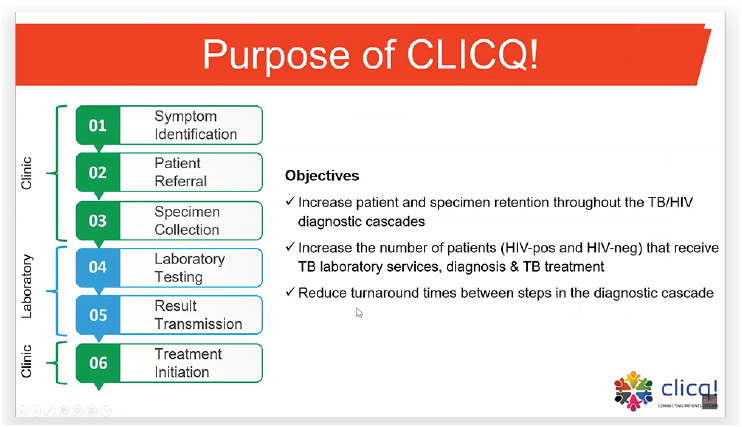ECHO Sessions Summary: September to December 2022

LabCoP ECHO sessions between September and December 2022 featured best practices at the clinic-laboratory interface to optimise the tuberculosis (TB)/HIV diagnostic cascade, optimise the diagnostic network in Gabon, and integrate hepatitis C testing on existing TB and HIV infrastructure in Nigeria. LabCoP also launched the Diagnostic Network Optimisation (DNO) sub-Community of Practice (sub-CoP) in collaboration with FIND and explored opportunities for funding DNO exercises in the next Global Fund Grant Cycle (GC7).
The loss of patients to follow-up along the TB diagnostic cascade remains a critical gap in case detection and treatment. Tightening potential drop-offs along the testing cascade requires that clinics and laboratories interface to ensure service continuity from patient entry to a facility to specimen collection and transportation to the laboratory for testing and result reporting. Nigeria and Uganda have piloted CLICQ! (Cascade via Implementation of the Clinic-Laboratory Interface Continuous Quality Improvement), a mentorship-based programme that uses a diagnostic cascade evaluation (DiCE) toolkit to identify, quantify, and target gaps in TB. The September 2022 ECHO session highlighted how both pilot programmes demonstrated an increase in the total number of patients with presumptive TB, the number of TB treatment initiations, and the number of specimens collected and tested. In addition, CLICQ! improved the working relationship between the laboratory and clinical staff at facilities as they deliberately defined common goals. Watch the session here.

Nigeria has one of the largest viral hepatitis burdens in the world, with an estimated 2 million hepatitis C virus (HCV) cases and 16 million hepatitis B virus cases. As highlighted in the December 2022 ECHO session, some of the causes of the low detection of HCV cases include the high cost of HCV viral load (VL) tests (over $140 per test in the private sector), limited access in some states, and long turnaround times (TAT) to results return (an average of 90 days TAT from sample collection to results dispatch). Additionally, many HCV-seropositive patients may experience delayed initiation of treatment. Nasarawa State shows a classic example of addressing these challenges by leveraging HIV and TB laboratory infrastructure for HCV diagnostics. Pilot results for six months indicated that near-point-of-care (POC) testing enabled access to on-site HCV testing, resulting in quicker TATs (from an average of 90 days to 12 days) for the return of HCV VL results to patients while maintaining TB testing service delivery. The HCV-TB integration pilot successfully demonstrated the feasibility and positive impact of integrated testing on the GeneXpert. Nasarawa State has leveraged lessons learned from VL testing integration to build momentum towards HCV elimination. Watch the session here.
In September 2022, LabCoP launched the DNO sub-CoP, a collaboration between ASLM and FIND, which aims to improve the uptake and quality of DNO processes in LabCoP-participating countries. The DNO sub-CoP is a growth point of the body of knowledge on DNO, and its application in various use cases. The sub-CoP also aims to promote the availability and quality of data, as well as capacity building and stakeholder coordination to conduct analyses, implement findings and sustain efforts. Watch the session here.
The December 2022 DNO sub-CoP session covered the funding opportunity for DNO in the upcoming grant cycle 7 of the Global Fund. The Global Fund 2022 Modular Framework now includes DNO as an eligible intervention, and Patrick Royle, Project Manager at the Global Fund, shared tips for successful DNO funding requests. These include seeking early engagement with key stakeholders to align with the scope, objectives, and expected outputs of DNO analysis, prioritising key activities required to achieve DNO analysis, and identifying the necessary resources for supportive activities to maximise the benefits of DNO. Watch the session here.
